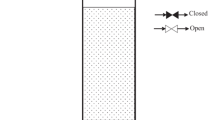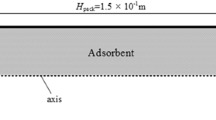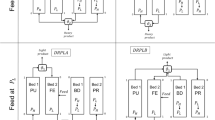Abstract
Effects of variable feed composition on the performance of a pressure swing adsorption process are analyzed by simulation. Two scenarios are considered. The first, “increasing impurity,” case considers low impurity concentration in the feed followed by high impurity concentration in the feed. The second, “decreasing impurity,” case considers high impurity concentration in the feed followed by low impurity concentration in the feed. These results are compared against a case which has an impurity concentration in the feed at an average of the high and the low impurity concentrations. Simulations show that the increasing impurity scenario is expected to perform better, and the decreasing impurity scenario is expected to perform worse than the average feed concentration case.
Similar content being viewed by others
Abbreviations
- b :
-
Langmuir parameter
- C Pg :
-
ΣC Pgi (T) ·y i , heat capacity of the gas phase
- C Ps :
-
adsorbent heat capacity
- C vg :
-
ΣC vgi (T) ·y i , heat capacity of the gas phase
- d p :
-
particle diameter
- D :
-
bed diameter
- ε :
-
total bed voidage
- ε i :
-
interstitial void fraction
- hw :
-
bed to wall heat transfer coefficient
- k :
-
mass transfer coefficient
- m :
-
monolayer capacity of the adsorbate
- n :
-
solid phase loading
- P :
-
total pressure
- PFAC :
-
proportionality parameter for mass transfer coefficient
- q :
-
isosteric heat of adsorption
- R :
-
gas constant
- ρ :
-
gas phase mass density
- ρ b :
-
bulk density of the adsorbent
- ρ g :
-
gas phase molar density
- T :
-
system temperature
- t :
-
time variable
- T w :
-
wall temperature
- μ :
-
viscosity
- v :
-
superficial linear velocity
- x :
-
distance variable
- y :
-
gas phase mole fraction
- i :
-
component
- *:
-
corresponding equilibrium concentration
References
Batta, L.B., U.S. Patent #3,564,816, February 23, 1971.
Kumar, R., U.S. Patent #4,913,709, Apr. 3, 1990.
Kumar, R., “Pressure Swing Adsorption Process: Performance Optimum and Adsorbent Selection,”I&EC Research,33, 1600 (1994).
Kumar, R., V.G. Fox, D.G. Hartzog, R.E. Larson, Y.C. Chen, P.A. Houghton, and T. Naheiri, “A Versatile Process Simulator for Adsorptive Separations,”Chem. Eng. Sci.,49(18), 3115 (1994).
Kumar, R. and W.C. Kratz, U.S. patent #5,133,785, Jul. 28, 1992.
Ruthven, D.M.,Principles of Adsorption and Adsorption Processes, John Wiley & Sons, 1984.
Ruthven, D.M., S. Farooq, and K. Knaebel,Pressure Swing Adsorption, VCM Publishers, 1994.
Author information
Authors and Affiliations
Rights and permissions
About this article
Cite this article
Kumar, R. Effect of variable feed concentration on the performance of a pressure swing adsorption process. Adsorption 1, 203–211 (1995). https://doi.org/10.1007/BF00704224
Issue Date:
DOI: https://doi.org/10.1007/BF00704224




